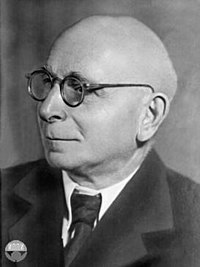Sergei Natanovich Bernstein
Sergei Natanovich Bernstein | |
|---|---|
 Sergei Natanovich Bernstein | |
| Born | (1880-03-05)5 March 1880 Odessa, Kherson Governorate, Russian Empire |
| Died | 26 October 1968(1968-10-26) (aged 88) Moscow, Soviet Union |
| Residence | Russian Empire, Soviet Union |
| Nationality | Soviet |
| Alma mater | University of Paris |
| Known for | Bernstein's inequality in analysis Bernstein inequalities in probability theory Bernstein polynomial Bernstein's theorem (approximation theory) Bernstein's theorem on monotone functions Bernstein problem in mathematical genetics |
| Scientific career | |
| Fields | Mathematics |
| Institutions | University of Paris University of Goettingen University of Kharkiv Leningrad University Steklov Institute of Mathematics |
| Doctoral advisor | Charles Émile Picard David Hilbert |
| Doctoral students | Yakov Geronimus Sergey Stechkin |
Sergei Natanovich Bernstein (Russian: Серге́й Ната́нович Бернште́йн, sometimes Romanized as Bernshtein; 5 March 1880 – 26 October 1968) was a Russian and Soviet mathematician of Jewish origin known for contributions to partial differential equations, differential geometry, probability theory, and approximation theory.[1][2]
Contents
1 Work
1.1 Partial differential equations
1.2 Probability theory
1.3 Approximation theory
2 Publications
3 See also
4 Notes
5 References
6 External links
Work
Partial differential equations
In his doctoral dissertation, submitted in 1904 to the Sorbonne, Bernstein solved Hilbert's nineteenth problem on the analytic solution of elliptic differential equations.[3] His later work was devoted to Dirichlet's boundary problem for non-linear equations of elliptic type, where, in particular, he introduced a priori estimates.
Probability theory
In 1917, Bernstein suggested the first axiomatic foundation of probability theory, based on the underlying algebraic structure.[4] It was later superseded by the measure-theoretic approach of Kolmogorov.
In the 1920s, he introduced a method for proving limit theorems for sums of dependent random variables.
Approximation theory
Through his application of Bernstein polynomials, he laid the foundations of constructive function theory, a field studying the connection between smoothness properties of a function and its approximations by polynomials.[5] In particular, he proved
the Weierstrass approximation theorem[6][7] and Bernstein's theorem (approximation theory).
Publications
- S. N. Bernstein, Collected Works (Russian):
- vol. 1, The Constructive Theory of Functions (1905–1930), translated: Atomic Energy Commission, Springfield, Va, 1958
- vol. 2, The Constructive Theory of Functions (1931–1953)
- vol. 3, Differential equations, calculus of variations and geometry (1903–1947)
- vol. 4, Theory of Probability. Mathematical statistics (1911–1946)
- S. N. Bernstein, The Theory of Probabilities (Russian), Moscow, Leningrad, 1946
See also
- A priori estimate
- Bernstein algebra
- Bernstein's inequality (mathematical analysis)
- Bernstein inequalities in probability theory
- Bernstein polynomial
- Bernstein's problem
- Bernstein's theorem (approximation theory)
- Bernstein's theorem on monotone functions
- Bernstein–von Mises theorem
- Stone–Weierstrass theorem
Notes
^ Youschkevitch, A. P. "BERNSTEIN, SERGEY NATANOVICH". Dictionary of Scientific Biography..mw-parser-output cite.citation{font-style:inherit}.mw-parser-output q{quotes:"""""""'""'"}.mw-parser-output code.cs1-code{color:inherit;background:inherit;border:inherit;padding:inherit}.mw-parser-output .cs1-lock-free a{background:url("//upload.wikimedia.org/wikipedia/commons/thumb/6/65/Lock-green.svg/9px-Lock-green.svg.png")no-repeat;background-position:right .1em center}.mw-parser-output .cs1-lock-limited a,.mw-parser-output .cs1-lock-registration a{background:url("//upload.wikimedia.org/wikipedia/commons/thumb/d/d6/Lock-gray-alt-2.svg/9px-Lock-gray-alt-2.svg.png")no-repeat;background-position:right .1em center}.mw-parser-output .cs1-lock-subscription a{background:url("//upload.wikimedia.org/wikipedia/commons/thumb/a/aa/Lock-red-alt-2.svg/9px-Lock-red-alt-2.svg.png")no-repeat;background-position:right .1em center}.mw-parser-output .cs1-subscription,.mw-parser-output .cs1-registration{color:#555}.mw-parser-output .cs1-subscription span,.mw-parser-output .cs1-registration span{border-bottom:1px dotted;cursor:help}.mw-parser-output .cs1-hidden-error{display:none;font-size:100%}.mw-parser-output .cs1-visible-error{font-size:100%}.mw-parser-output .cs1-subscription,.mw-parser-output .cs1-registration,.mw-parser-output .cs1-format{font-size:95%}.mw-parser-output .cs1-kern-left,.mw-parser-output .cs1-kern-wl-left{padding-left:0.2em}.mw-parser-output .cs1-kern-right,.mw-parser-output .cs1-kern-wl-right{padding-right:0.2em}
^ Lozinskii, S. M. (1983). "On the hundredth anniversary of the birth of S. N. Bernstein". Russ. Math. Surv. 38: 163. doi:10.1070/RM1983v038n03ABEH003497.
^ Akhiezer, N.I.; Petrovskii, I.G. (1961). "S. N. Bernshtein's contribution to the theory of partial differential equations". Russ. Math. Surv. 16.
^ Linnik, Ju. V. (1961). "The contribution of S. N. Bernšteĭn to the theory of probability". Russ. Math. Surv. 16 (2): 21&ndash, 22. doi:10.1070/rm1961v016n02abeh004103. MR 0130818.
^ Videnskii, V. S. (1961). "Sergei Natanovich Bernshtein — founder of the constructive theory of functions". Russ. Math. Surv. 16: 17. doi:10.1070/RM1961v016n02ABEH004102.
^ S. Bernstein (1912–13) "Démonstration du théroème de Weierstrass, fondeé sur le calcul des probabilités, Commun. Soc. Math. Kharkow (2) 13: 1-2
^ Kenneth M. Lavasseur (1984) A Probabilistic Proof of the Weierstrass Theorem, American Mathematical Monthly 91(4): 249,50
References
O'Connor, John J.; Robertson, Edmund F., "Sergei Natanovich Bernstein", MacTutor History of Mathematics archive, University of St Andrews.
External links
Sergei Natanovich Bernstein at the Mathematics Genealogy Project
Sergei Natanovich Bernstein and history of approximation theory from Technion — Israel Institute of Technology
Author profile in the database zbMATH